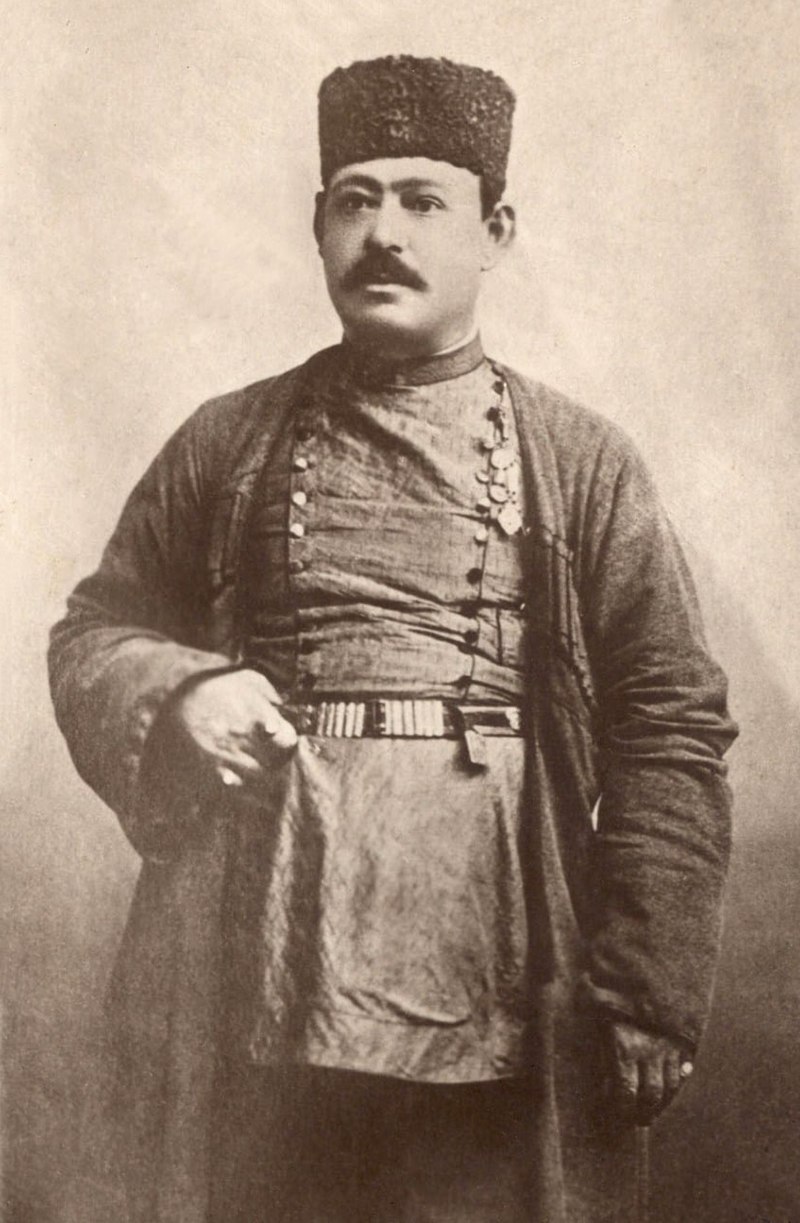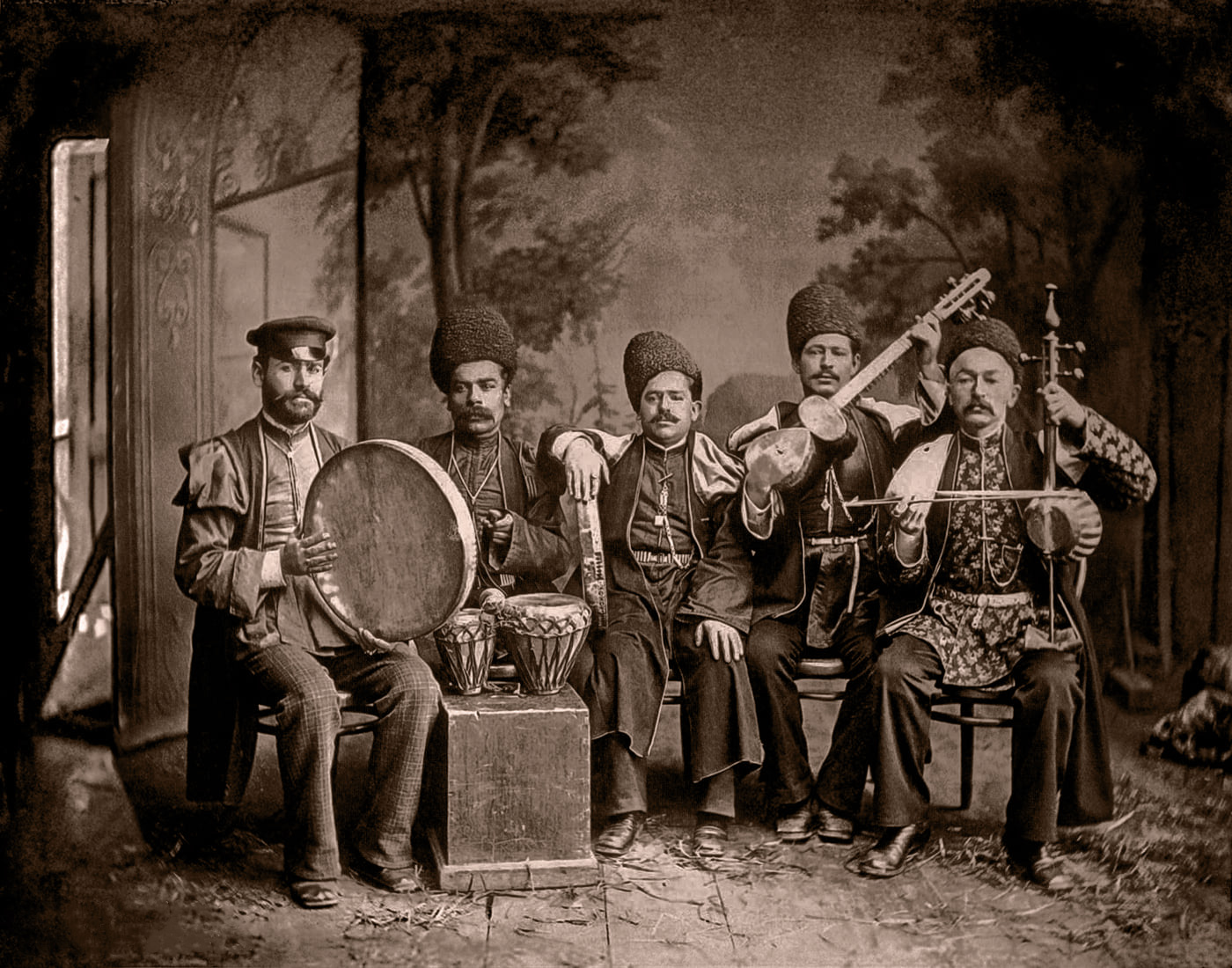Azerbaijani folk musician, tar player Sadigjan (Mirza Sadig Asad oghlu) was born in 1846, in the city of Shusha, in a poor family. However, in the “Music Encyclopedia” of 1978, the date of his birth is indicated as 1842.
[Ch.Kajar. The famous sons of ancient and medieval Azerbaijan. 1995, p. 217]
[Music Encyclopedia. Volume 4, 1978, p. 814]
[The Azerbaijani Soviet Encyclopedia. Volume VIII, 1984, p. 255]
 Sadig received his musical education at the school of the Azerbaijani teacher Kharrat Kuli Muhammad oghlu in Shusha. After losing his voice at the age of 17-18, Sadig, at first, played flute, ney, kamancheh, and then studied tar at the music school of Mirza Ali Asker. The book of the Azerbaijani art historian Firudin Shushinsky notes the following: “They say that initially Mirza Sadig played in the ensemble of Mirza Ali Asker on the kamancheh, which played a secondary role here, and only once, when his teacher fell ill, Mirza Sadig managed to play on tar and demonstrate his phenomenal abilities to everyone. After that, Mirza Sadig devoted himself completely to playing this wonderful instrument, further improved his proficiency, and perfected his technique.”
Sadig received his musical education at the school of the Azerbaijani teacher Kharrat Kuli Muhammad oghlu in Shusha. After losing his voice at the age of 17-18, Sadig, at first, played flute, ney, kamancheh, and then studied tar at the music school of Mirza Ali Asker. The book of the Azerbaijani art historian Firudin Shushinsky notes the following: “They say that initially Mirza Sadig played in the ensemble of Mirza Ali Asker on the kamancheh, which played a secondary role here, and only once, when his teacher fell ill, Mirza Sadig managed to play on tar and demonstrate his phenomenal abilities to everyone. After that, Mirza Sadig devoted himself completely to playing this wonderful instrument, further improved his proficiency, and perfected his technique.”
Soon Sadig surpassed his teacher Mirza Ali Asker in the workmanship of his playing on tar. Mirza Ali Aske in turn spoke of him as follows: “I would like Sadig to have my wealth, and I would like to have his fingers.”
[Ch.Kajar. The famous sons of ancient and medieval Azerbaijan. 1995, p. 217]
Mirza Sadig participated in the activities of the literary society “Mejlisi – faramushan” (“Mejlisi of the Forgotten”) and the musical society “Mejlisi-khananda” (“Society of Musicians”) organized by Azerbaijani musicologist Mir Mohsun Navvab and Khurshidbanu Natavan in Shusha.
[Ch.Kajar. The famous sons of ancient and medieval Azerbaijan. 1995, p. 216]
Sadigjan introduced some innovations in Azerbaijani mughams. Having developed “Segyah”, he added a neck to the tar for “Zabul” and improved “Mahur”. Sadigjan also composed several ryangs (an instrumental musical genre of Azerbaijani professional music of the oral tradition) for the mughams “Orta Segyah” and “Bayaty Shiraz”.
[Ch.Gajar. The famous sons of ancient and medieval Azerbaijan. 1995, p. 217]
[F. Shushinskiy. Shusha. 1968, p. 112-113]
[The Azerbaijani Soviet Encyclopedia. Volume VIII, 1984, p. 255]
In the “Kavkazskoye obozreniye” newspaper the following is written about Sadigjan: “His playing is distinct, artistically precise and charmingly strong. It would not be a bad thing for our Tiflis composers to take advantage of Sadig’s staying in Tiflis and learn oriental motifs from him, which will serve them as good material for new compositions.”
[Ch.Gajar. The famous sons of ancient and medieval Azerbaijan. 1995, p. 217]
 In 1875-1878 Sadigjan, for the first time changed the design of tar. He increased the number of strings (from 5 to 11), changed the structure of the fretboard and the frame of the tar, improved their fastening and reduced the overall weight of the instrument. Sadigjan also developed a new technique of playing tar, and began to hold the instrument clutching to his chest. Before him, musicians played on tar, holding it on their knees. Azerbaijani art critic Firudin Shushinskiy noted: “These innovations and changes made by Sadigjan have expanded the performing possibilities of playing this instrument. After the introduction of their mughams, performed on the tar, they sounded brighter and more colorful. The improved tar, was called by people as “magic tar”, and Sadigjan as the “father of tar””. Soon Sadigjan’s tar completely replaced the old, so-called “Iranian tar” from all over the Caucasus and Central Asia.
In 1875-1878 Sadigjan, for the first time changed the design of tar. He increased the number of strings (from 5 to 11), changed the structure of the fretboard and the frame of the tar, improved their fastening and reduced the overall weight of the instrument. Sadigjan also developed a new technique of playing tar, and began to hold the instrument clutching to his chest. Before him, musicians played on tar, holding it on their knees. Azerbaijani art critic Firudin Shushinskiy noted: “These innovations and changes made by Sadigjan have expanded the performing possibilities of playing this instrument. After the introduction of their mughams, performed on the tar, they sounded brighter and more colorful. The improved tar, was called by people as “magic tar”, and Sadigjan as the “father of tar””. Soon Sadigjan’s tar completely replaced the old, so-called “Iranian tar” from all over the Caucasus and Central Asia.
[F.Shushinskiy. Shusha. 1968, p. 112-113]
[Ch.Kajar. The famous sons of ancient and medieval Azerbaijan. 1995, p. 217]
[Music Encyclopedia. Volume 4, 1978, p. 814]
[The Azerbaijani Soviet Encyclopedia. Volume VIII, 1984, p. 255]
[Encyclopedia of Uzeyir Hajibeyov. 2003, p. 183]
Sadigjan accompanied on tar the Azerbaijani khanendes Haji Husi, Abdul-Baghi Zulalov (Bulbuljan), Jabbar Karyaghdy oghlu and Mashadi Isi. In 1875, Sadigjan together with Bulbuljan moved to Tbilisi (Georgia) and performed concerts there. In 1880 Sadigjan, as a member of the Mashadi Isi ensemble, was invited to the city of Tabriz (Iran) for the wedding party of Muzafaraddin Mirza, the son of Nasreddin Shah Qajar. At this wedding, Sadigjan was awarded the Order of “Shiri-Khurshid” (the Order of the Lion and the Sun).
[Ch.Kajar. Outstanding sons of ancient and medieval Azerbaijan. 1995, p. 217]
[The Azerbaijani Soviet Encyclopedia. Volume VIII, 1984, p. 255]
[F. Shushinskiy. Shusha. 1968, p. 99]
In the 1890s Sadigjan organized a musical ensemble that gave concerts in many cities of Azerbaijan, also in Istanbul (now Turkey), Ashgabat (now Turkmenistan) and Tehran (now Iran).
[The Azerbaijani Soviet Encyclopedia. Volume VIII, 1984, p. 255]
[F.Shushinskiy. Shusha. 1968, p. 112]
Sadigjan composed the music for the play “Majnun on the grave of Leyli” (1897), which was staged in Shusha under the direction of the Azerbaijani writer Abdurrahim bey Hagverdiyev.
[Encyclopedia of Uzeyir Hajibeyov. 2003, p. 183]
[D. Ahmed. Selected. 2020, p. 177]
[Ch.Gajar. The famous sons of ancient and medieval Azerbaijan. 1995, p. 217]
In 1901, Sadigjan participated in the first Oriental concert in Shusha. Here, for the first time, he performed the mugham “Mahur” (“Orta Mahur”).
[Ch.Kajar. The famous sons of ancient and medieval Azerbaijan. 1995, p. 217]
[F. Shushinskiy. Shusha. 1968, p. 112]
The Azerbaijani composer and publicist Afrasiyab Badalbeyli appreciated the role of Sadigjan in Azerbaijani music in the following way: “If we take into account that when performing mugham, tar takes the first place among all musical instruments, then it can be argued that Mirza Sadig’s discoveries ultimately marked a turning point in the history of Azerbaijani music. It can be said that due to Mirza Sadig, the essence of Azerbaijani mughams, their expressive means, the power of influence and the techniques of performing these mughams have risen to a new level. Mirza Sadig opened a new page in the origins of Azerbaijani music.”
[Ch.Kajar. The famous sons of ancient and medieval Azerbaijan. 1995, p. 216]
Azerbaijani composer Uzeyir Hajibeyov assessed Sadigjan in this way: “The names and fame of the tar players, like Sadig, became known throughout the Caucasus, and acquired international significance.”
[Encyclopedia of Uzeyir Hajibeyov. 2003, p. 106]
The followers and successors of Sadigjan’s school were tar players – Mashadi Zeynal, Gurban Pirimov, Mashadi Jamil Amirov, Malybeyli Hamid, Shirin Akhundov and Bahram Mansurov.
[F. Shushinskiy. Shusha. 1968, p. 112-113]
[The Azerbaijani Soviet Encyclopedia. Volume VIII, 1984, p. 255]
Sadigjan died in 1902 in Shusha.
[Ch.Kajar. The famous sons of ancient and medieval Azerbaijan. 1995, p. 217]
[Music Encyclopedia. Volume 4, 1978, p. 814]
In May 1992, after the occupation of Shusha by the Armenian armed forces, Sadigjan’s house, in which he lived, was destroyed.




